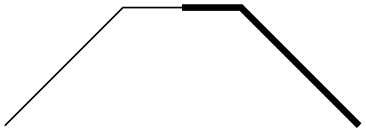Manual for Package pgfplots
2D/3D Plots in LATeX, Version 1.18.2
https://github.com/pgf-tikz/pgfplots
Related Libraries
5.5Decoration: Soft Clipping
-
\usepgfplotslibrary{decorations.softclip} % LaTeX and plain TeX ¶
-
\usepgfplotslibrary[decorations.softclip] % ConTeXt ¶
-
\usetikzlibrary{pgfplots.decorations.softclip} % LaTeX and plain TeX ¶
-
\usetikzlibrary[pgfplots.decorations.softclip] % ConTeXt ¶
Activates decoration=softclip.
A “soft clip” is a part of an input path, namely that part which is inside of the “clip path”. This
is typically known as clipping: you set \clip  path
path ; and all following paths are clipped against
; and all following paths are clipped against
 path
path . Soft-clipping is similar, but instead of installing a low-level clip path, it modifies the input path in a way such that
only parts inside of
. Soft-clipping is similar, but instead of installing a low-level clip path, it modifies the input path in a way such that
only parts inside of
 path
path remain. This makes a difference if decorations are to be applied. It also makes a difference for
fill between/soft clip.
remain. This makes a difference if decorations are to be applied. It also makes a difference for
fill between/soft clip.
Note that this library is loaded implicitly by the fillbetween library in order to address its fill between/soft clip key.
Attention: this library is considered to be experimental. It will work for paths which are similar to a plot, i.e. paths which do not intersect themselves and which have a clear direction. The library might fail, in general.
An application could be to draw a path twice, but the second time should only affect portions of the path:

\begin{tikzpicture}
\draw [
postaction={decorate,draw,ultra thick},
decoration={
soft clip,soft clip path={
(1.5,-1) rectangle
(4,2)
},
},
]
(0,0) --
(1,1) -- (2,1) -- (3,0);
\end{tikzpicture}
The soft clip feature is tailored for use with fill between. Please refer to the documentation of fill between/soft clip for more examples and explanation on soft-clipping.
-
/pgf/decoration/soft clip path=
 corner1
corner1 rectangle
rectangle
 corner2
corner2 ¶
¶
Assigns the path which is to be used for the soft clip decoration. This argument is mandatory in order to apply a soft clip decoration.
Please refer to the documentation of fill between/soft clip for details; it has the same syntax and a similar motivation.
-
/pgf/decoration/every soft clipped path(style, no value) ¶
A style which is applied just before the reduced path is generated.